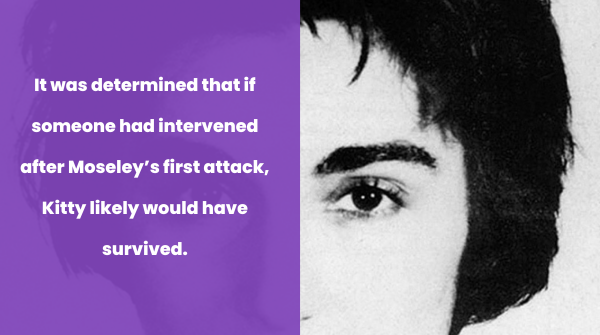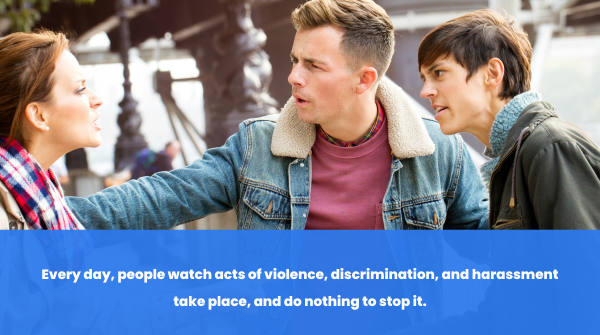The Basics of Bystander Intervention
Bystander Intervention
Bystander Intervention refers to when one or more person steps in to help in emergency situations. A person who observes a situation where discrimination, violence, or harassment is occurring is considered a bystander; and if this individual decides to intervene in the situation, they become an upstander.
Bystander Effect
The Bystander Effect is a social psychology theory that refers to the idea that people are less likely to intervene in situations of concern when there are other people observing what is unfolding. This theory is best explored through the 1964 murder of 28-year-old Kitty Genovese in Kew Gardens, Queens, New York. This case received nationwide attention due to the initial reports that stated 38 of Kitty’s neighbors saw the murder take place but did not call the police or get help.
Around 3 a.m. on March 16, 1964, Kitty Genovese was on her way home after her shift at a local bar when she was attacked by 28-year-old Winston Moseley. Moseley had been driving around in search of a victim when he first spotted Kitty at a traffic light. After she parked her car in an alleyway and started to walk to the entrance of her apartment building, he approached her with his hunting knife. When she noticed him and the knife, she attempted to escape, but was unable to outrun him. Moseley stabbed her twice in the back and as she screamed for help, lights in the surrounding apartments began turning on. After one of Kitty’s neighbors yelled “leave that girl alone!”, Moseley was spooked and fled the scene. At this time, Kitty’s wounds were not fatal, and she was able to get inside her apartment building before collapsing in the hallway. Barely ten minutes later, Moseley returned and repeatedly stabbed Kitty. He then raped and stole $49 from her before running from the building.
Shortly after Moseley left, Kitty’s friend, Sophia Farrar, found Kitty unconscious and bleeding on the floor. Sophia immediately called the police and held Kitty in her arms until they arrived at 3:52 a.m., two minutes after the call was made. Kitty was taken away in an ambulance at 4:15 a.m. and died on the way to Queens General Hospital. It was determined that if someone had intervened after Moseley’s first attack, Kitty likely would have survived.
The public’s reaction and national attention that was given to this murder case prompted social psychologists John Darley and Bibb Latané to research the bystander effect. Darley and Latané proposed the concept of diffusion of responsibility as being one reason the bystander effect may occur. Diffusion of Responsibility refers to when more than one person is observing the problematic situation and because of the presence of other people, intervention is less likely. This is due to the idea that an individual may think someone else will intervene in the situation since they are not alone; therefore, transferring the responsibility of taking action onto another person.

The Five Steps of Bystander Intervention
Darley and Latané (1970) developed the Decision Model of Helping, which consists of five steps that a bystander must go through when deciding whether or not to intervene in a situation. These steps are:
- Notice the problematic situation and observe what is happening.
- Evaluate the situation and decide whether intervention is needed.
- Take responsibility for intervening.
- Understand how to approach the situation.
- Decide what course of action you will take.
There are different methods to how someone can intervene. These are referred to as the 5Ds.
The 5Ds
The 5Ds are five courses of action a bystander can take when they have determined intervention is needed. They include:
- Distract - Interrupt the situation and divert the harasser’s attention away from the victim. Examples of how attention can be diverted include:
- Pretending you know the victim and excitedly express how happy you are to have noticed they were there.
- Spill a drink or drop a bag “accidentally” to shift both the perpetrator’s and victim’s attention away from each other.
- Pretend to be lost and ask the victim for directions, and if they can walk you towards where you are trying to go.
- Delegate - Ask another person to help with intervening. If possible, this person should have some form of authority. An example of this is speaking to someone near you and pointing out what is happening. Then, with this person, quickly produce a plan of how to intervene and get between the perpetrator and victim.
- Document - If someone is already helping to intervene, take notes or record the situation. Only do this if you are in a safe position to do so. Do not share pictures or videos taken of what happened without the permission of the victim.
- Delay - If it is not possible to intervene in the situation while it is happening, check in with the victim after the harassment has stopped. Examples of what to say/ask the victim include:
- “Are you okay?”
- “Do you need help getting somewhere safe?”
- “Do you need me to call someone for you?”
- “Do you want to talk about what just happened?”
- Direct - Confront the harasser. Make sure it is safe for you to do this before taking this action. Examples of what to say to them include:
- “She asked you to leave her alone, so leave her alone.”
- “You are making them uncomfortable, please stop.”
- “What you’re saying to him is inappropriate and you need to stop.”
The Importance of Intervention
Every day, people watch acts of violence, discrimination, and harassment take place, and do nothing to stop it. The deferment of responsibility can result in no action being taken, such as what happened in the case of Kitty Genovese. The bystander effect creates an environment where a bystander is less likely to become an upstander, something that everyone has the personal responsibility to try and become. Becoming familiar with the 5 steps of bystander intervention – distract, delegate, document, delay, direct – along with what makes a culture riddled with violence against not just women, can help create a safer world for all.
For further learning, check out this TED talk by Jackson Katz and download the graphics below to show your support!

_.webp)




